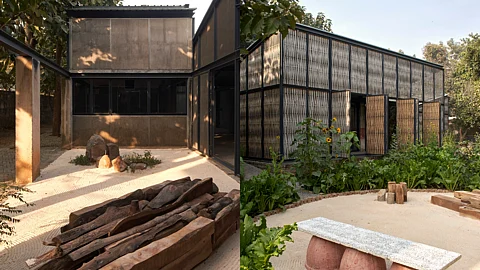
- HOMEGROWN WORLD
- #HGCREATORS
- #HGEXPLORE
- #HGVOICES
- #HGSHOP
- CAREERS
- ABOUT US
- CONTACT US

What do you think of when you think of bamboo?
Historically, in many parts of northeast India, bamboo was the material of choice for building homes and shelters. In the valleys of Assam, Arunachal Pradesh, Mizoram, Manipur, and Nagaland, where bamboo is plentiful, the traditional houses of the tribespeople were built on a foundation of bamboo stilts, with walls made with woven bamboo mats covered in a plaster of mud and clay from the riverbeds.
These bamboo homes were some of the earliest types of semi-permanent settlements in the region. In fact, despite the widespread adoption of modern reinforced cement concrete (RCC) housing across northeast India, traditional bamboo homes still exist in many remote parts of Assam and Arunachal Pradesh. In many cases, these primitive, indigenous forms of shelter tend to be more suitable to the terrain and climate of the region than modern RCC houses.
New Delhi-based Studio Array's design for the Farm8 artist residency in Arjanghar, New Delhi, draws from these indigenous architectural traditions to create an eco-conscious space for artists. Conceived nearly a decade ago by celebrated artists Ranbir and Rashmi Kaleka as a personal studio, the project began with the casting of foundations and columns before stalling for unforeseen reasons. By 2020, the site had evolved into something more significant: a working permaculture farm at the heart of New Delhi, and a space for the artist collective Farm8, whose members include the Kalekas, Bharti Kher, Subodh Gupta, Jagannath and Pranati Panda, Jogen Chowdhury, Shambavi Singh, Meera Menezes, Rajiv Bhargava, Anil Chandra, Manoj Arora, Eegje Schoo, and the late Sanjeev Sinha and Vivan Sundaram.
When Studio Array was engaged, the project shifted from being a private studio for the Kalekas to a shared sanctuary for the collective. This space invites visiting artists from India and abroad to immerse themselves in nature while escaping the demands of city life. Principal architect Rachit Srivastava and his team chose not to erase the past; instead, they embraced the existing concrete skeleton as a half-finished canvas. They wrapped it in lightweight steel, glass, bamboo, and wooden drywall, aligning with the Farm8 collective's permaculturalist ethos of minimizing waste, reusing existing materials, and allowing the architecture to organically evolve from its inherited structure.
The design intertwines contrasting elements: old and new, indoors and outdoors, public and private. By emulating the experience of sitting beneath a tree, the architects created semi-open spaces within the existing column grid, providing shelter without full enclosure. The modular sloping roofs, angled thoughtfully in response to function, light, and context, break down the massing, frame views of the surrounding greenery, and create a sense of lightness in the built form. Instead of overwhelming the site, these roofs serve as gentle visual guides, continually drawing the eye back to the farm's lush greenery.
Inside, spaces unfold in varying volumes and scales, with double-height verandahs extending the living quarters and blurring the boundaries between personal and communal areas. Large openings are softened by handwoven bamboo screens, which provide privacy while allowing light and air to filter through. Over time, these screens will weather and darken, becoming part of the landscape's natural rhythm. The brick flooring, laid without mortar, invites grass and weeds to infiltrate the pavilions, while lime-finished walls and polished cement floors add warmth and tactility indoors.
By embracing the unfinished past and building on it as a foundation, Studio Array has created a space that dissolves the boundaries between inside and outside, art and agriculture, permanence and change through adaptive reuse. Today, the Farm8 artist residency stands as a reminder that architecture can be rooted in place, respectful of its history, and open to the evolving life it shelters.
